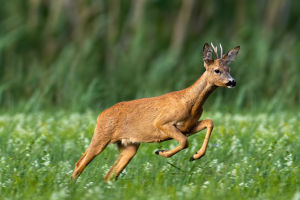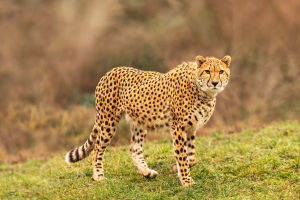
Have you ever heard of a "vampire deer"? It’s not some mythical creature from a fantasy story, but a real animal that exists today. This fascinating species, also known as the Hydropotes inermis or the water deer, has a unique feature—fang-like tusks that set it apart from other deer.
While its appearance might remind you of something out of a horror movie, the vampire deer is a real and endangered species. Let's dive into the world of this incredible animal and explore what makes it so special.
What is the Vampire Deer?
The vampire deer is a small species of deer that primarily resides in eastern China and the Korean Peninsula. Despite its name, it doesn’t actually drink blood. Instead, it is known for its elongated canine teeth, which resemble fangs, giving it the "vampire" nickname. Unlike other deer species, both male and female vampire deer lack antlers. Instead, only the males grow long, sharp tusks that can reach up to 8 cm in length. These teeth are the key feature that makes them stand out.
Physical Characteristics of the Vampire Deer
The vampire deer is a compact creature, with a body length of 77 to 100 cm (including the head), and a shoulder height between 45 and 55 cm. They have short, rounded ears and a coat that ranges from a rich brown in the young to a lighter yellow-brown in adults. Their legs are long compared to their body, and their back legs are notably longer than the front ones, which gives them a distinctive, rabbit-like hopping gait.
Interestingly, their tusks are the most eye-catching feature. While the males' tusks are significantly longer, averaging 8 cm, the females have much shorter tusks. These tusks are used for defense and to assert dominance during mating season or when protecting their territory.
Habitat and Distribution
Vampire deer are native to China and the Korean Peninsula, but their population has dwindled due to habitat loss and human activity. In China, they are classified as an endangered species, and they are now found mainly in wetlands, such as those near the Zhoushan Islands, Hongze Lake, and Dongting Lake. Unfortunately, the species was declared extinct in Taiwan in the 19th century, but they still thrive in specific regions in mainland China.
Behavior and Territory
Vampire deer are territorial animals, especially the males. They mark their territory using their scent and feces, and will aggressively defend their space from intruders. If another male enters their domain, a fight may ensue. The two males will use their tusks to try and injure each other, targeting vital areas such as the head, neck, or back. These battles typically end when one of the males either concedes or flees.
Females, on the other hand, are less territorial outside of the breeding season. However, during the time when they are about to give birth, they become more protective, actively driving away other females that come too close to their young.
Reproduction of the Vampire Deer
The breeding season for vampire deer takes place every year between November and December. During this time, the males will track the scent of females to determine whether they are in heat. Most mating occurs within the male's territory, where he courts the female. After mating, the female's gestation period lasts between 170 and 210 days, with most births occurring between May and July.
A female vampire deer typically gives birth to one to three fawns per year, which is considered relatively high compared to other deer species. After giving birth, the mother will lead her fawns to dense vegetation where they can be hidden from predators. This ensures their safety as they grow and mature.
Why Should We Care About the Vampire Deer?
The vampire deer is an important species within its ecosystem, playing a role in maintaining the balance of the environment. Unfortunately, due to human encroachment and habitat destruction, their numbers have dwindled. Conservation efforts are crucial to protect this unique animal and ensure that future generations get to witness the fascinating sight of a deer with fangs.
By supporting wildlife preservation initiatives and educating others about the vampire deer, we can help make a difference. Together, we can work to protect the natural habitats of these incredible creatures and safeguard the delicate balance of the ecosystems they inhabit.
The Vampire Deer’s Future
The vampire deer is not just a curiosity, but a symbol of the many species around the world that face the threat of extinction. By understanding and appreciating creatures like the vampire deer, we can learn more about the importance of biodiversity and conservation. Let’s all do our part to protect this fascinating animal and the habitats that sustain it. So next time you hear about the "vampire deer," you'll know that it's not just a story—it's a call to action for all of us to contribute to preserving the natural world.
To all our readers, we hope you’ve enjoyed learning about the vampire deer. Feel free to share your thoughts in comment section. What do you think about the vampire deer? Would you love to see one in the wild?
Roe Deer Species Guide: Appearance, Diet, Habitat, Behavior, Stats, And Conservation Status
video by In Focus


